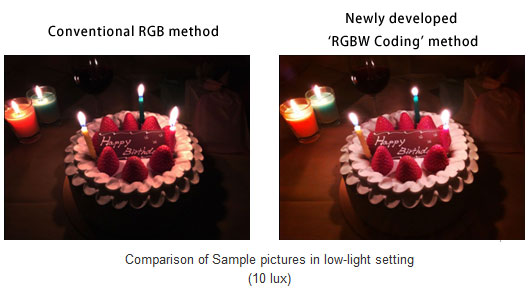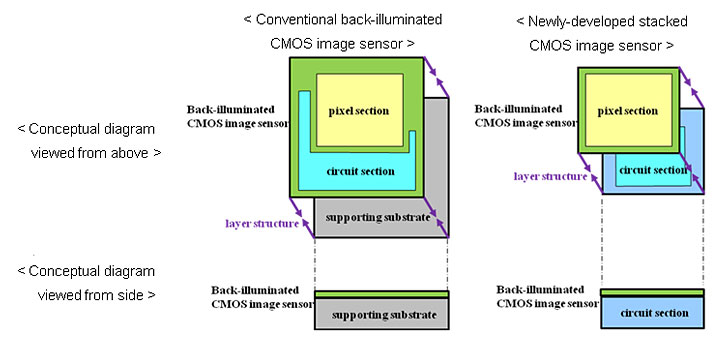Now Cell phone and small compact camera can capture HDR Video with the help of new Sensor developed by Sony, Sony’s unique “RGBW Coding” function which allows you to capture better low light images with less noise. Sony has also developed a model with built-in signal processing functionality, an element that usually requires external embedment.
Sony has successfully developed new stacked CMOS image sensor technology that realizes higher image quality and superior functionality in a more compact size. The three newly developed next-generation back-illuminated CMOS image sensor models will be the first to utilize this technology. Samples will begin to successively ship starting March 2012.
Features of stacked CMOS image sensor
- Large-scale signal processing circuits required for higher image quality and better functionality are built-in
- More compact image sensor chip size
- Even higher image quality of the pixel section by adopting manufacturing processes specialized for superior image quality
- Faster speeds and lower power consumption by adopting the leading process for the circuit section
About stacked CMOS image sensors
Conventional CMOS image sensors mount the pixel section and analog logic circuit on top of the same chip, which require numerous constraints when wishing to mount the large-scale circuits such as measures to counter the circuit scale and chip size, measures to suppress noise caused by the layout of the pixel and circuit sections, and optimizing the characteristics of pixels and circuit transistors.
Sony has succeeded in establishing a structure that layers the pixel section containing formations of back-illuminated structure pixels over the chip affixed with mounted circuits for signal processing, which is in place of supporting substrates used for conventional back-illuminated CMOS image sensors. By this stacked structure, large-scale circuits can now be mounted keeping small chip size. Furthermore, as the pixel section and circuit section are formed as independent chips, a manufacturing process can be adopted, enabling the pixel section to be specialized for higher image quality while the circuit section can be specialized for higher functionality, thus simultaneously achieving higher image quality, superior functionality and a more compact size. In addition, faster signal processing and lower power consumption can also be achieved through the use of leading process for the chip containing the circuits.
Press Release
Tkyo, Japan – January 23, 2012 – Sony Corporation (“Sony”) today announced the development of two CMOS image sensor models designed for use in smartphones and other devices. They are equipped with Sony’s unique “RGBW Coding” function which allows images to be captured with low noise and high picture quality even in low-light conditions. They also contain Sony’s “HDR (High Dynamic Range) Movie” function which allows brilliant color to be captured even in bright settings. Sony has also developed a model with built-in signal processing functionality, an element that usually requires external embedment.
Sony has successfully developed new stacked CMOS image sensor technology that realizes higher image quality and superior functionality in a more compact size. The three newly developed next-generation back-illuminated CMOS image sensor models will be the first to utilize this technology. Samples will begin to successively ship starting March 2012.
Background of development (new functions)
The recent proliferation of smartphones and other devices has increased casual shooting opportunities and there is demand for the evolution of cameras to be able to shoot in a diverse range of settings. In particular, consumers want to easily take pictures in low light conditions or those with both low and bright lights. Sony has incorporated its two newly developed models with its unique “RGBW Coding” function which enables high-sensitivity shooting even in low-light conditions and its “HDR Movie” function which can capture images or video across a broad dynamic range of low-light to bright-light conditions.
About the key functions incorporated in the new CMOS image sensors
1. Sony’s unique “RGBW Coding” function enabling clear shooting in dark rooms or at night
The built-in “RGBW Coding” function which adds W (White) pixels to the conventional range of RGB (Red-Green-Blue) pixels has realized higher sensitivity, enabling high-quality shooting with low noise even in dark indoor or night settings.
While the addition of W (White) pixels improves sensitivity, it has the problem of degrading image quality. However, Sony’s own device technology and signal processing realizes superior sensitivity without hurting image quality. Furthermore, while the individual pixels of the newly developed models are extremely minute at 1.12μm, the incorporation of the “RBGW Coding” function has realized a SN ratio (signal-to-noise ratio) equivalent to that of a unit pixel size of 1.4μm under conventional methods, which in turn has enables the image sensors to achieve a higher resolution at a more compact size.
The new models are also able to output signals through the conventional RGB method, thus there is no need to change the signal processing adopted in existing devices.

2. “HDR (High Dynamic Range) Movie” function which enables brilliant colors to be captured even in bright settings
The built-in “HDR Movie” function enables brilliant colors to be captured even in settings with a wide range of light including bright light.
Typically, when shooting with differing light levels, such as an indoor setting against a bright outdoor background, there can easily be blocked up shadows for dark areas or blown out highlights for bright areas. Such phenomena are a result of the combination of low-light and bright-light which have different optimal exposure conditions in the same shot. This function reduces this by setting two different exposure conditions within a single screen shooting and conducts the appropriate signal processing for the captured image information under each optimal exposure condition. This process generates an image with a broad dynamic range and enables shooting of both the background and subject matter with brilliant colors even in a bright environment.
Upcoming product launches (plan)
・ Type 1/4 Stacked CMOS Image Sensor with approx. 8.0 effective megapixels
(equipped with camera signal processing function*1)
Sample shipments planned for March, 2012
・ Type 1/3.06 Stacked CMOS Image Sensor with approx. 13.0 effective megapixels
(equipped with “RGBW Coding” and “HDR Movie” functions)
Sample shipments planned for June, 2012
・ Type 1/4 Stacked CMOS Image Sensor with approx. 8.0 effective megapixels
(equipped with “RGBW Coding” and “HDR Movie” functions)
Sample shipments planned for August, 2012
*1 Not equipped with “RGBW Coding” or “HDR Movie” functions







